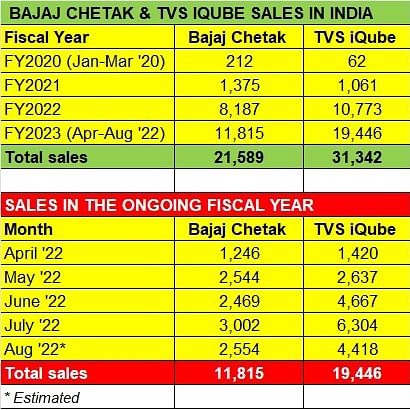TVS iQube and Bajaj Chetak ride surging wave of EV demand in April-August 2022
TVS iQube with 19,446 units and Bajaj Chetak with 11,815 units in the first five months of FY2023 race past their cumulative sales in the first 27 months (January 2020-March 2022) since launch.
As demand for electric two-wheelers maintains a strong growth trajectory in India, ICE two-wheeler and electric scooter rivals Bajaj Auto and TVS Motor Co are also making robust gains with their electric scooters. Interestingly, both companies launched their products – the Bajaj Chetak and TVS iQube – in the same month: January 2020.
Proof of the rising market demand for TVS iQube and Bajaj Chetak is that their combined sales till end-August 2022 have crossed the 50,000-unit mark. While TVS Motor Co with 31,342 units has the larger share – 59% – of the pie, Bajaj has sold a total of 21,589 units over the past 32 months.

A close look at the data tables above, which reflect sales numbers released by apex industry body SIAM, reveals that for both OEMs, sales in the first five months of FY2023 (April-August 2022) have gone past their respective cumulative sales over the first 27 months since launch.
While Bajaj has sold 11,815 Chetaks in the first five months of FY2023, its total sales from January 2020 to March 2022 were 9,774 units. Similarly, TVS has 19,446 units to its credit in April-August 2022, way ahead of its 11,876 units sold in the 27-month January 2020-March 2021 period.
At this time last year, Bajaj and TVS were more or less at par: the Chetak with 2,087 units and the iQube with 2,135 units in the April-August 2021 period. A year later, while both products have seen greater connect in the EV marketplace, it is TVS which has taken the lead. The TVS iQube's sales of 19,446 units in April-August 2022 are an 810% YoY increase while the Bajaj Chetak’s 2,087 units registered 466% YoY growth, albeit this big-ticket increases are on a low year-ago base.
Bajaj Auto would have registered higher sales numbers but for the fact that the Chetak is being sold in fewer markets than its TVS rival. Now there are plans to expand the retail network. At the end of July, in an analysts’ call, executive director Rakesh Sharma said the aim is to grow four-fold to 100 cities over the next two years. The current network strength for the Bajaj e-scooter is 27 outlets.
The Chetak EV, which is sold in two variants – Premium and Urbane – is priced at Rs 151,958 (on-road Delhi). The Chetak gets fully charged in 4 hours and has a quick charge of 25% in 60 minutes. At full charge, it delivers a range of 90km in Eco Mode. Manufactured at the Chakan plant, it has three riding modes including a reverse mode.
TVS seems to have benefitted from the rollout of the refreshed iQube in May 2022, priced between Rs 98,564 and Rs 108,690 (on-road Delhi) including the FAME and other state subsidies, for the entry-level iQube and iQube S trims, respectively. In terms of network, the new iQube is available in 33 cities and is slated to reach 52 more cities within India.
TVS Motor has also introduced a top-spec iQube ST variant with a range of 140km on a single charge. This is nearly twice the range of 75km on the earlier model.
The refreshed iQube retains its all-LED lights and 12-inch wheels but gets a host of connectivity features, driven by the various TFT instrument clusters on offer. While the entry-level iQube gets a 5-inch unit that supports turn-by-turn navigation, the iQube S comes equipped with a larger 7-inch TFT cluster that offers music controls and theme personalisation as well. The ST variant, on the other hand, features a 7-inch touchscreen instrument cluster, which is also ready for OTA updates, as well as offers voice assistance.
With stiff petrol prices and several Indian states offering plenty of incentives to accelerate electric mobility, both the Bajaj Chetak and TVS iQube should continue to see robust demand in the coming months. They, no doubt, have plenty of competition particularly from Hero Electric and Okinawa Autotech but what clicks in their favour is their strong brand image, reliable aftersales support and an expanding market launch strategy.
ALSO READ
EVs take 3.6% of two-wheeler sales in India in H1 2022
RELATED ARTICLES
Mahindra BE 6, XEV 9e sales cross 19,000 in H1 2025, EV retail market share rises to 17%
Between January and June, Mahindra & Mahindra has produced 19,915 units of its two electric-origin SUVs from the Chakan ...
EV sales in India race past a million units in first-half CY2025
Riding on strong double-digit growth in the 2-, 3-wheeler and passenger vehicle segments, India EV Inc sells 10,47,788 v...
Electric car and SUV sales jump 53% to 74,539 units in H1 2025, JSW MG and M&M grab 49% share
Following four straight months of 13,000-plus sales and best-ever monthly retails of 13,397 units in June, electric pass...





 04 Sep 2022
04 Sep 2022
 28025 Views
28025 Views





 Ajit Dalvi
Ajit Dalvi




